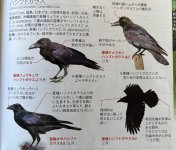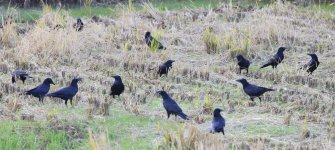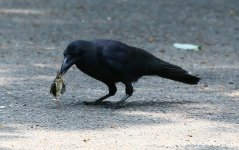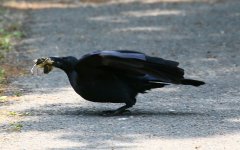Hello Gerben, hope you are well.
Like you, in Japan (in my case in the centre Nara near Osaka and Kyoto, about 60km from the sea and 100m asl), I see clear Large-billed and clear Carrion, but also quite a lot of birds that I am unsure of.
If the forehead is clearly bulbous, then whatever about the bill, I put it down as Large-billed. And there are birds that are clearly (I think) Carrion, some however with quite a large bill.
Nonetheless, there are quite a lot of birds which I am not sure of - and I can't decide whether to give the vote to the large bill or the apparent forehead shape.
However, I don't have any personal hobby-horses in relation to these species, and I post this just in case others with knowledge or opinions might have something interesting to say.
I attach two photos below which show detail from a photo guide that is specifically about differentiation of close species. And then a photo three from an illustrated guide that I think is excellent. I hope all this is 'fair use'.
Photo one: this shows only Large-billed Crow, but the problem here is that the author has chosen to depict three standing birds which are all from outlying islands, and only the flying bird is the main Japanese sub-species. However, he does say that the top right bird has no essential visual differences from the main Japanese bird.
Photo two: this shows the differences between the head view of (L-R) Carrion, Large-billed, Rook and Raven.
My comments on Photo one are that it can be seen that at least two sub-species of Large-billed illustrated do not show the bulbous head. And the flight picture specifically says that the bulbous forehead can often (usually) not be seen when birds are in flight. And given this, I wonder whether there might be significant variation in head shape between individual birds even in regions where the bulbous head ssp is supposed to be the sole ssp? And also, if the bulbous head is not usually visible in flight, then maybe it isn't strongly obvious in standing birds seen from a certain angle or a certain light.
And a comment on photo two is that given the posture of the birds, I can't see much difference between the Carrion and Long-billed photos in forehead shape or apparent bill size or feathering of the bill. However, in both Photo two and Photo one (top right bird), the author points out as a definitive distinguishing feature between the two species that the tip of the upper mandible of the bill in Long-billed curves down and over the tip of the lower mandible, but that this is not the case in Carrion (i.e. the bill of Long-billed has a 'nail' but the bill of Carrion does not). But how often can this feature be seen? And if there are Long-billed with not-so-bulbous heads, then there must be intermediate birds that are difficult to split between the two species on a casual (ordinary) view, even with a photograph.
And so to Photo three. As you can see from the flight photos, this guide agrees with Photo one that the forehead shape and bill size are not useful identifiers in flight, though it is suggested that primary pattern can be distinctive - with the middle primaries sticking out more relatively in Carrion than in Long-billed. Hmmm!
And from Photo three, you can see that Large-billed, according to this author, develops the bulbous forehead as an adult, so that juvenile Long-billed resembles Carrion both juvenile and adult, which is specifically stated (the text just above the bill of the illustration of Large-billed juv). So maybe some of the problem birds that I have and that Gerben has are with Juvenile Long-billed and slightly larger-billed Carrion.
Comments from others on these observations are welcome.
Also three questions:
1. Is there any possibility that feeding as a chick has an effect on adult size, not just overall but on the size of the bill and the forehead? One reason for asking this is that I mentioned the asl and distance from the sea of my location at the beginning of this post because it is my impression that Large-billed near the coast, whether official ssp or simply regional variation, are much more obvious (large bills, large foreheads) in general than inland birds, so I wonder if a fish diet could be significant. But I stress this is just an impression.
2. Given that they overlap, might there not be some inter-breeding between Large-billed and Carrion, and between Large-billed ssp?
3. Sexual differences in bill and forehead shape and size?
And the fourth photo is just a view from my window (where I am writing this post) in late December a few years ago. I think these are all quite clear as to species.
But the fifth photo is from my regular spot not far from my house. I think these are also quite clear as to species.
So, Photos four and five are basically from the same location (2km apart at maximum 'as the Crow flies' hahaha).
To repeat: these are just comments and observations, and I have enough clear photos of birds of each species. But if anyone has something interesting to say about differentiation of 'intermediate' birds, then I would be very interested.
Photos six and seven are just to illustrate the point. From Photo six, I went for Large-billed because of the bill, but Photo seven has such a shallow forehead that I have to go for Carrion. I don't know. (The prey is an Oriental Greenfinch.)





















